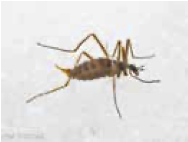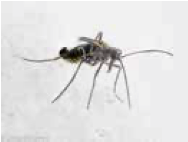Be a Winter Insect Hunter
Published Mar 1st, 2021 by Lynnwood Andrews
Nature will bear the closest inspection. She invites us to lay our eye level with her smallest leaf, and take an insect view of its plain.
Henry David Thoreau
Looking for new things to explore on your winter hikes? Delve into the world of winter insects, spiders and other such creatures. To get you started, below are five tiny insects and a near-relative that live in Norwich. You will find great resources at iNaturalist to help you identify your discoveries and learn about new animals to look for. From the iNaturalist home page, click on the Explore tab at the top. Enter Norwich, VT USA in the Location window and use the filter button to the right to specify the kind of animal you are looking for and the dates (Nov 2020 – March 2021 for winter observations). Up will pop all of the observations made this winter in Norwich of whatever kind of animal you selected. As many insects and spiders are hard to identify at the species level without specialized equipment and knowledge, try learning them by common name and genus.
 Photo credit Erika Mitchell.
Photo credit Erika Mitchell.
Winter Crane Fly (Genus Trichocera)
Winter Crane Flies overwinter as adults, mostly males, and can be seen on warmer sunny days in winter. Although they look like big mosquitos, they do not bite or sting. In summer, their larvae live in moist areas, feeding on decaying plant material.
 Photo credit Erika Mitchell.
Photo credit Erika Mitchell.
Snow Fly (Genus Chionea)
These wingless insects can be observed walking on the snow in the afternoon in lightly forested areas. The adults live for up to two months, and produce glycerol to prevent freezing. They drink, but do not eat.
 Photo credit Erika Mitchell.
Photo credit Erika Mitchell.
Winter Firefly (Ellychnia corrusca)
These are lantern-less (no light) beetles that feed on flowers and sap, preferring oak, hickory and tuliptree. Adults spend the winter in grooves in tree bark and become active in March.
 Photo credit Erika Mitchell.
Photo credit Erika Mitchell.
Snow Scorpionflies (Genus Boreus)
These small insects have either no wings or tiny bristle-like. Their body temperature depends on absorption of radiation. The heat of a human hand can easily kill it.
 Photo credit Erika Mitchell.
Photo credit Erika Mitchell.
Small Winter Stonefly (Family Capniidae)
The nymphs emerge from below streambeds in winter. They moult into adult form and climb out onto the ice and snow. Even though they have wings, the adults prefer to walk on the snow in search of mates.
 Photo credit emendela.
Photo credit emendela.
Snow Fleas, also known as Springtails (Genus Hypogastrura)
Snow fleas are not true insects, but are hexapods. They look like flecks of pepper on snow. They can launch themselves into the air by means of an appendage called a furcola on their undersides. Bodily concentrations of proteins allow them to stay active in freezing temperatures.
Originally published in Spring 2021 Norwich Times